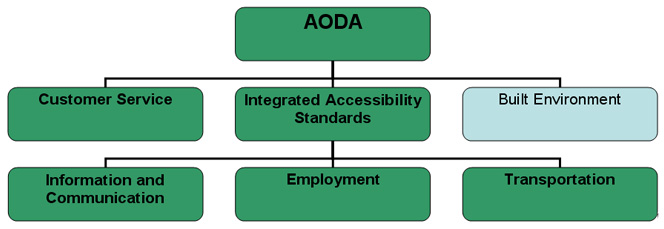Assuming your company (yes even if you are a one person operation!) is now in compliance with the Customer Service Standard (CSS) of the AODA, the harder part of the AODA should now be in your focus.
I will devote the next few Blogs to explaining this next phase referred to as IASR or the Integrated Accessibility Standards Regulations.
There are 3 components in this blended Regulation which includes;
1. Employment Standards
2. Communications and Information
3. The Build Code with Accessible Addendum (now under review until March 1st 2013).
In today’s Blog I will start with the Employment Standard. This standard will now require employers (private employers this pertains to you now) to provide an accessible environment across all stages of the employment cycle from recruit to talent management (and absence management).
It will be critical now for employers to bring real estate, facility managers, designers, architects who work with your company. The reason for this is barriers in the workplace need to be removed at all points of the employment cycle for all potential employees. By employees this Regulation stipulates this can include full time, part time, paid apprentices and students. This may include unpaid staff in certain circumstances.
Learning more about the Human Rights Code for Ontario will be critical for all of the key players in your workplace (Optimal has an e learning tool about the Human Rights Code as it relates to the AODA available for purchase) as the AODA has created the framework around the essence of the Human Rights Code for Ontario re. accommodation for disabilities,
Accessibility will now move from just being a tool for the management of disabilities & the return to work of employees with work related and non-work related injuries and illness. It will now under the AODA IASR will move into the regular workplace processes from recruitment to testing to hiring to career development and promotions.
The requirements under the Employment Standard for the IASR include ensuring accommodations are made for all disability types outlined in the Human Rights Code for Ontario. As well the stages of employment where this applies includes;
- Recruitment, assessment/testing, selection
- Providing accessible formats and communication supports for employees and potential employees
- Workplace emergency response information
- Documented individual accommodation plans
- The return to work and disability management process
- Performance Management
- Career development, advancement and lateral moves
- Redeployment
Bottom Line and Next Steps
Optimal Performance has been providing accommodation advice and workplace design advice in the area of Disability Management for over 22 years. Our Ergonomic Team has been providing high level ergonomic and universal design expertise for industry and administrative work environments. It is these two areas of expertise which now need to be included for the work teams you will need to create in your workplace. Engineers, architects, interior designers, IT, communications, HR, and Facility Managers need to sit together to learn more about the IASR and specifically about the Employment Standard. An audit of all of the related programs in place including purchasing, IT software and hardware, human resources policies and procedures, FM/Architectural/engineering/designers processes and approaches need to be reviewed at the same time. From this a Strategic Approach to compliance with the Employment Standards is required and this is where experienced consultants who know your business operations well will be an asset. Following this review a written Plan for Compliance is required both for the business strategy and operational impact. As well these written plan are required under the mandatory reporting to the Accessibility Directorate of Ontario (ADO) on a scheduled basis.
The CSS phase of the AODA roll out was the easy part for business. Human resource managers were most often delegated to ensure all of the CSS training of employees was completed and to ensure Policies were written correctly and placed into the correct areas of the business.
This next phase, the IASR will no longer be within the scope of practice or expertise of human resources alone. The IASR will require a coordinated, strategic approach by Sr Level Directors and Managers who can fully operationalize the AODA’s IASR.
The time to move on this is now as timelines are short for compliance. The outcomes for early adopters of the IASR will include major and tangible benefits including;
- locating and hiring excellent and qualified employees;
- compliance with regulatory requirements for the province;
- excellence in Diversity and Inclusion in the workplace to the benefit of the business
- enhanced brand and business reputation,
to name a few. When you are ready to sit down as a team seriously consider calling in the experts in this field for the initial meeting so as to wade through all of the material, standards and regulatory language in an efficient and accurate way. This will play a critical part in guaranteeing the success and strategic implementation of the IASR as part of the overarching AODA process for Ontario.
JE Sleeth Team Lead


